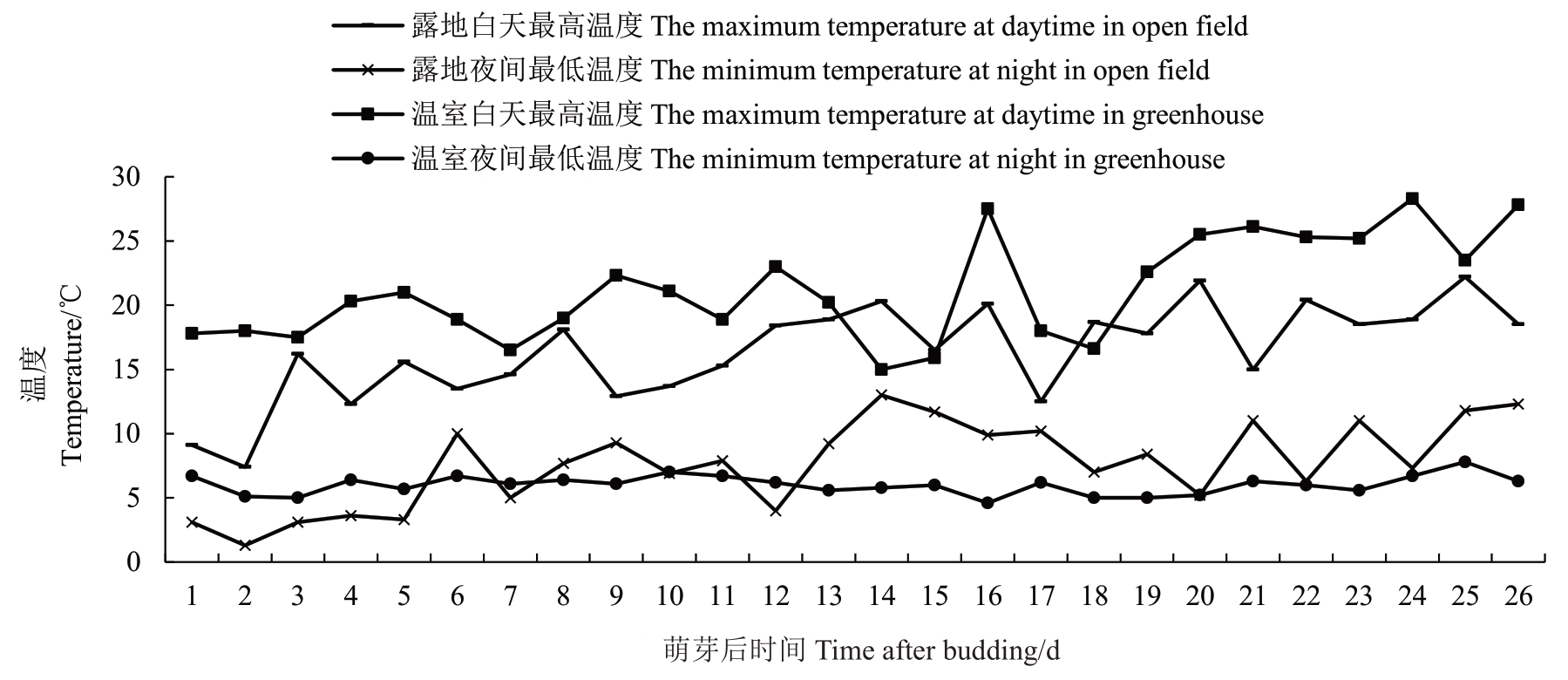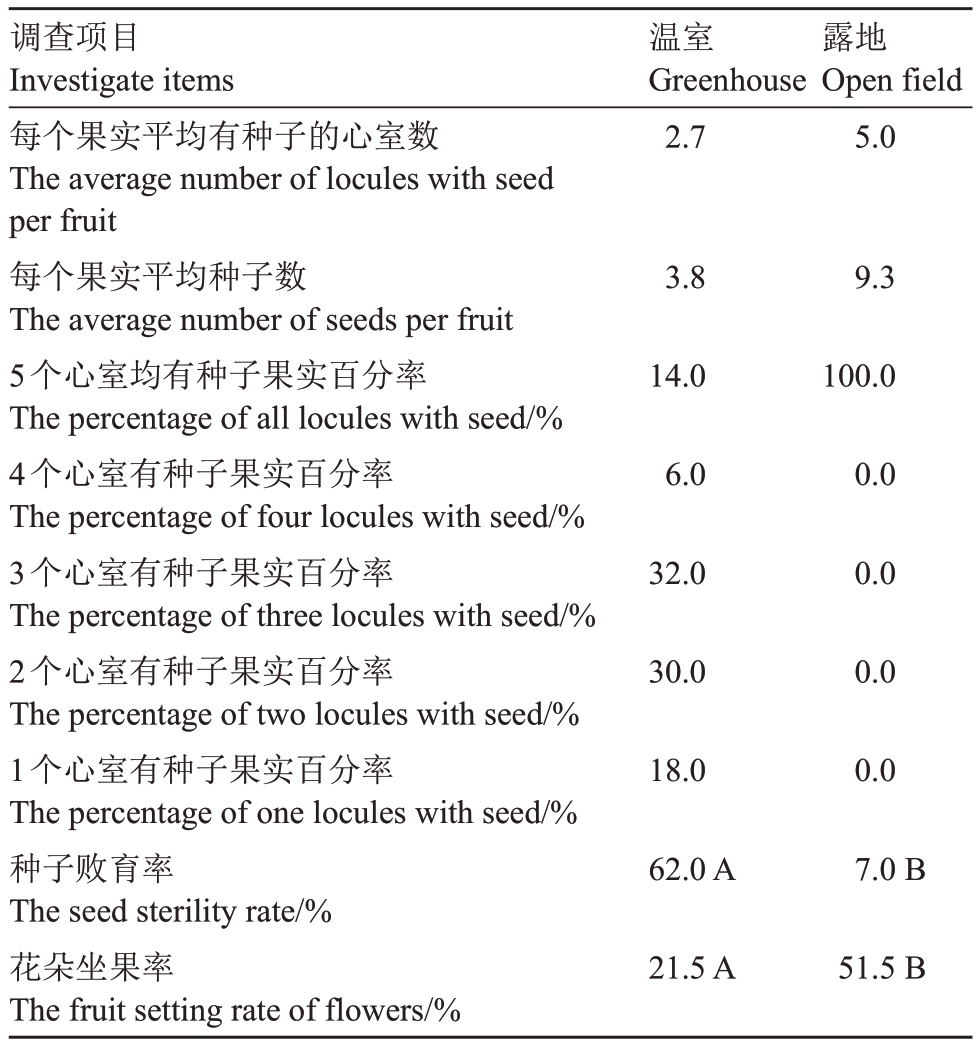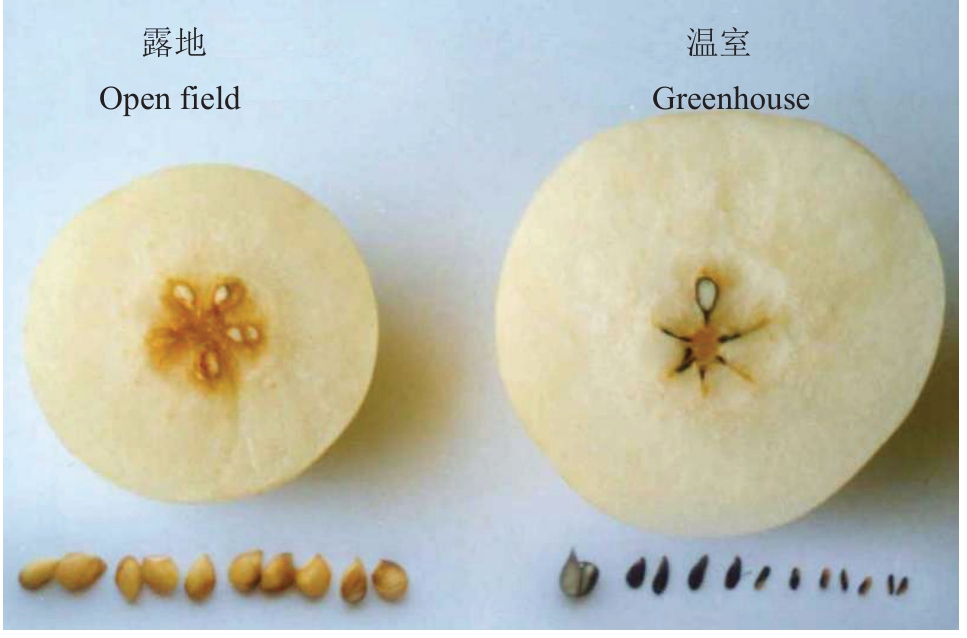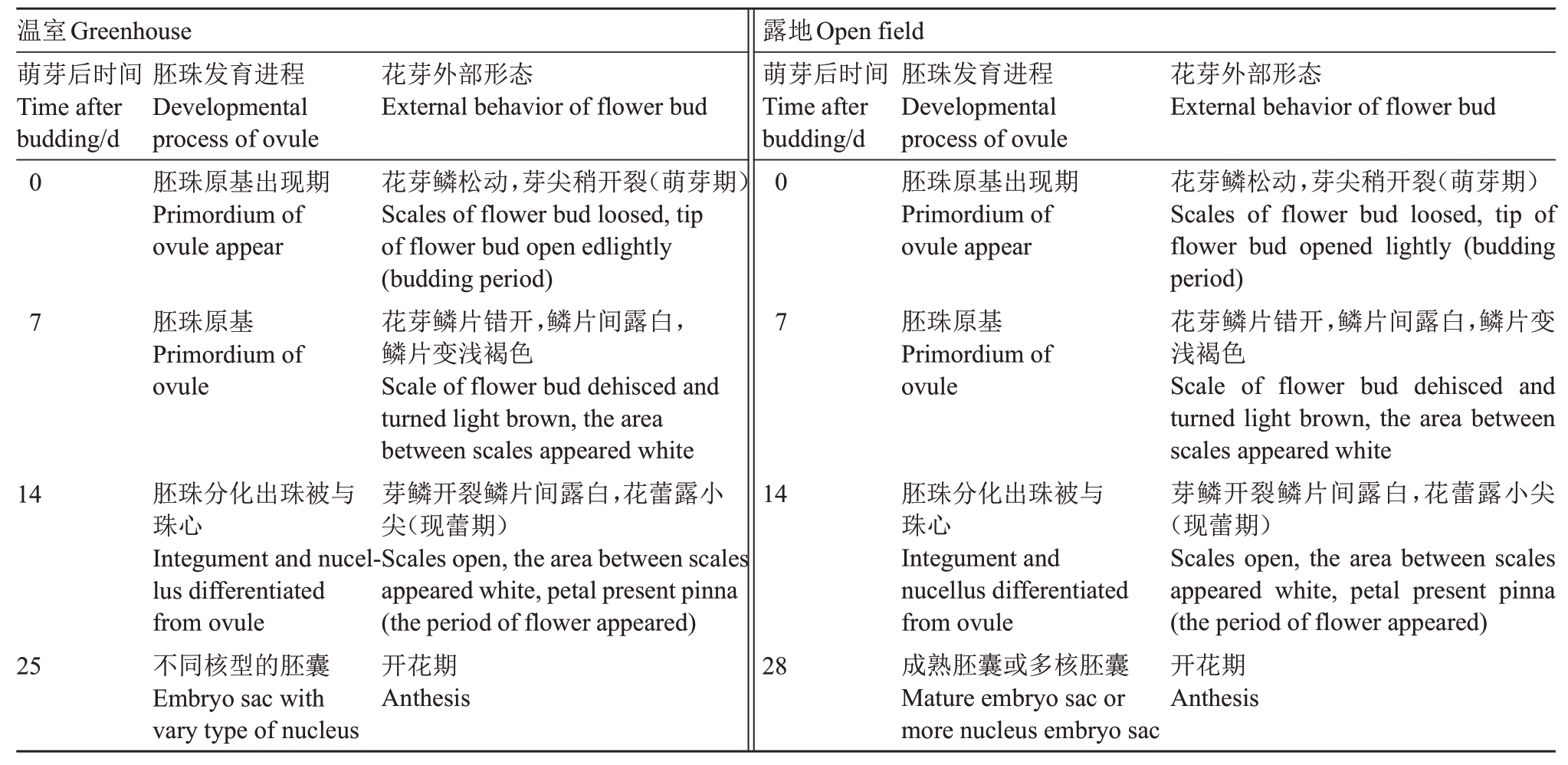黄金梨早期丰产性强,品质优良,但耐贮藏性较差,冷藏条件下,一般只能贮藏3~4个月[1]。温室栽培技术可充分发挥该品种的两大优势,延长果实供应期,增加果农的经济效益。但在生产中发现,温室栽培条件下黄金梨坐果率低,畸形果发生率高,在对温室落果、畸形果进行剖切过程中发现,多数果核内无种子。种子发育的任一方面,如胚珠、胚囊、花粉、授粉受精、胚、胚乳等发育过程受阻都可能引起种子败育[2]。而种子的前身是胚珠,胚珠是胚囊的携带者,胚珠发育过程中如出现形态结构异常、大孢子母细胞发育不完全或退化,都易导致植物雌性器官育性降低或不育[3]。边卫东等[4]曾对黄金梨的胚珠及花粉发育过程进行了切片观察,研究发现黄金梨从萌芽到花蕾期(开花前14 d),胚珠原基已分化出珠被和珠心,小孢子母细胞减数分裂后形成的四分体出现率达73.0%,并有早期花粉粒出现(27%);到开花前7 d,大孢子母细胞形成,胚珠分化完全,但早期花粉粒液泡化;到开花期胚囊形成,花药空囊。可见,黄金梨虽然无花粉或花粉极少,但雌蕊能正常发育,在栽培生产中如合理配置授粉树,则能有效解决花粉败育问题,提高坐果率。在授粉试验中发现八月酥、绿宝石、早酥梨均可作为黄金梨的授粉品种[5-6]。
此外,结合观察黄金梨[4]和甜樱桃[7-8]的胚珠及花粉发育过程发现,二者的胚珠、胚囊发育过程类似,其胚珠原基均在开花前14 d分化出珠心与珠被,且在开花期胚囊已经形成。同时,在观察甜樱桃的胚珠与温度变化相关性的过程中发现,甜樱桃胚囊的发育是在较低温度下完成,胚囊形成期平均最高温度为20.6 ℃,最低温度为7.9 ℃。在温室促成栽培条件下,温度的调控占主导地位,温度调控失常容易造成胚珠、胚囊发育异常,引起种子败育。为此,笔者从温室栽培黄金梨胚珠发育与温度变化的关系入手,对比调查了露地、温室栽培条件下气温变化规律、黄金梨的坐果率、种子败育率,以及同一物候期黄金梨的胚珠、胚囊发育过程,以求探明温室黄金梨种子败育率高、坐果率低的原因及其解决方法。
1 材料和方法
1.1 材料
试材取自河北科技师范学院园艺实验站日光温室梨及露地梨新品种栽培区。日光温室跨度7.0 m,脊高3.45 m,长62 m,温室内主栽品种为黄金梨,树龄为8年生,授粉品种有八月酥、绿宝石、早酥梨、黄冠,授粉树比例为30%。2020年1月1日温室升温,开花期为2 月5—12 日,6 月下旬—7 月上旬果实成熟。露地梨栽培区,黄金梨树龄均为8年生,开花期为4月15—22日,9月上旬果实成熟。
1.2 方法
1.2.1 温度观察 在露地栽培区,距地面1.5 m 高处随机安装3 个百叶箱,在温室栽培区的东、中、西部分别安装1个百叶箱,箱内均放置ZDR-20田间数据自动记录仪,每15 min自动采集1次温度数据,记录萌芽期至开花期的温度。
1.2.2 黄金梨坐果率及种子败育率调查 在温室、露地黄金梨萌芽期,分别挂牌选定50个短果枝,记录每个短果枝上的花朵数,在开花期统一进行人工授粉,并于花后20 d调查每个短果枝上坐果数。7月下旬温室黄金梨成熟后随机抽取50个果实与露地果实同期观察。横切果实,调查果实中种子败育情况。
1.2.3 黄金梨胚珠、胚囊解剖观察方法 分别于温室、露地黄金梨萌芽期开始采样,直至开花期,每次随机选取20 个顶花芽。温室黄金梨采样日期:1 月14 日、1 月21 日、1 月28 日、2 月8 日,露地黄金梨采样日期:3月23日、3月30日、4月6日、4月20日。将花芽取下后在室内剥去鳞片,用FAA 固定液固定,乙醇系列脱水,做成石蜡切片,番红、固绿对染,制成永久切片,在Olympus DP70 显微镜下观察胚珠、胚囊的发育情况及形态特征,并用测微尺测量开花期温室及露地黄金梨的胚珠、胚囊大小。
2 结果与分析
2.1 温室、露地气温比较
如图1 所示,温室夜间平均最低温度能保持在6.0 ℃,露地平均最低温度为7.7 ℃。从萌芽期至开花期温室白天平均最高温度为21.2 ℃,露地为16.8 ℃。萌芽期、现蕾期温室白天各阶段平均最高温度为19.6 ℃、22.9 ℃,露地为14.3 ℃、18.6 ℃,尤其是在开花前7 d,温室内白天平均最高温度高达26.0 ℃,露地仅为19.9 ℃。可见,温室白天最高气温普遍高于露地,且在大孢子母细胞形成后(即开花前7 d)平均白天最高气温超过了25 ℃。

图1 温室、露地温度变化规律
Fig.1 The changes of temperature in greenhouse and open field
2.2 温室、露地黄金梨种子发育及坐果情况
梨属仁果类,正常情况下每个果实有5个心室,每个心室中有2个胚珠,可形成10粒种子。由表1、图2可知,在露地栽培条件下,黄金梨种子败育率仅有7%,每个果实中平均有9.3 粒发育正常的种子且5 个心室中均有正常种子;温室栽培条件下黄金梨种子败育率高达62%,每个果实平均仅有3.8粒发育正常的种子,5个心室平均仅有2.7个心室中有正常的种子,其中以3个心室和2个心室有正常种子的果实比例最高,分别为32%、30%。温室栽培的黄金梨不仅种子败育率极显著高于露地栽培的黄金梨,而且其坐果率极显著地低于露地栽培的黄金梨。
表1 温室、露地黄金梨果实中种子分布及坐果率
Table 1 The seed distribution and fruit setting rate of Whangkeumbae pear in greenhouse and open field

注:不同大写字母表示在p<0.01 差异极显著。
Note:Different capital letters indicate extremely significant difference at p<0.01.
调查项目Investigate items每个果实平均有种子的心室数The average number of locules with seed per fruit每个果实平均种子数The average number of seeds per fruit 5个心室均有种子果实百分率The percentage of all locules with seed/%4个心室有种子果实百分率The percentage of four locules with seed/%3个心室有种子果实百分率The percentage of three locules with seed/%2个心室有种子果实百分率The percentage of two locules with seed/%1个心室有种子果实百分率The percentage of one locules with seed/%种子败育率The seed sterility rate/%花朵坐果率The fruit setting rate of flowers/%温室Greenhouse 2.7露地Open field 5.0 3.89.3 14.0100.0 6.00.0 32.00.0 30.00.0 18.00.0 62.0 A 7.0 B 21.5 A 51.5 B

图2 露地、温室栽培黄金梨种子败育情况
Fig.2 The seed sterility of Whangkeumbae pear in greenhouse and open field
2.3 温室、露地黄金梨胚珠发育过程及形态观察
由表2可知,露地栽培条件下,黄金梨从萌芽到开花需要经历28 d;由于栽培黄金梨的温室白天温度高,高温加快了温室黄金梨的开花速度,使得从现蕾到开花所需时间比露地缩短了3 d。无论是露地还是温室栽培的黄金梨,胚珠原基于萌芽期出现(图3-A~B),到现蕾期(萌芽后14 d),胚珠均已分化出珠被与珠心(图3-E~F)。到开花期,露地栽培黄金梨73.3%的胚囊完成分化(图3-G),其余处于不同的多核阶段(图3-H),且未检测出单核、二核及四核胚囊。而温室栽培黄金梨胚囊还处于大孢子母细胞减数分裂中,其中单核胚囊(图3-I)、二核胚囊(图3-J)、四核胚囊(图3-K)所占比例分别为27.8%、22.2%、11.1%。此外,在观察开花期胚珠、胚囊切片中发现,温室栽培黄金梨胚囊长度和宽度均小于露地黄金梨(表3),且变异系数大。
表2 温室、露地黄金梨胚珠发育进程
Table 2 The developmental process of ovule of Whangkeumbae pear in greenhouse and open field

温室Greenhouse萌芽后时间Time after budding/d 0花芽外部形态External behavior of flower bud花芽外部形态External behavior of flower bud胚珠发育进程Developmental process of ovule胚珠原基出现期Primordium of ovule appear花芽鳞松动,芽尖稍开裂(萌芽期)Scales of flower bud loosed,tip of flower bud open edlightly(budding period)花芽鳞片错开,鳞片间露白,鳞片变浅褐色Scale of flower bud dehisced and turned light brown,the area between scales appeared white芽鳞开裂鳞片间露白,花蕾露小尖(现蕾期)Scales open,the area between scales appeared white,petal present pinna(the period of flower appeared)开花期Anthesis胚珠发育进程Developmental process of ovule胚珠原基出现期Primordium of ovule appear胚珠原基Primordium of ovule露地Open field萌芽后时间Time after budding/d 0 7 7胚珠原基Primordium of ovule 14 14 25胚珠分化出珠被与珠心Integument and nucellus differentiated from ovule不同核型的胚囊Embryo sac with vary type of nucleus 28胚珠分化出珠被与珠心Integument and nucellus differentiated from ovule成熟胚囊或多核胚囊Mature embryo sac or more nucleus embryo sac花芽鳞松动,芽尖稍开裂(萌芽期)Scales of flower bud loosed, tip of flower bud opened lightly (budding period)花芽鳞片错开,鳞片间露白,鳞片变浅褐色Scale of flower bud dehisced and turned light brown, the area between scales appeared white芽鳞开裂鳞片间露白,花蕾露小尖(现蕾期)Scales open, the area between scales appeared white, petal present pinna(the period of flower appeared)开花期Anthesis
表3 温室、露地黄金梨胚珠、胚囊发育情况
Table 3 The development of ovule and embryo sac of Whangkeumbae pear in greenhouse and open field

处理Treatment露地Open field温室Greenhouse胚珠数The number of ovule 15 18胚珠大小The size of ovule/μm长度Length 531.7 384.7长度变异系数CV of length 7.8 8.6宽度Width 264.1 219.3宽度变异系数CV of width 6.4 6.7胚囊大小The size of embryo sac/μm长度Length 78.4 49.2长度变异系数CV of length 7.8 19.5宽度Width 32.9 21.8宽度变异系数CV of width 4.7 13.0

图3 温室、露地黄金梨胚珠、胚囊萌芽期至开花期解剖观察
Fig.3 Observation on ovule and embryo sac of Whangkeumbae pear in greenhouse and open field
结合温室黄金梨胚珠、胚囊发育情况及室内气温发现,正常情况下,在开花前7 d 大孢子母细胞开始减数分裂,至开花期胚囊形成。而此时温室内白天平均最高温度高达26.0 ℃,再加上室内高温缩短了现蕾期到开花期的时间,因此,使得温室栽培黄金梨胚囊存在明显的发育滞后现象,到开花期胚囊未发育完全。
3 讨 论
胚囊是雌性器官的主要组成部分,胚囊发育不完全或退化容易造成雌性器官不孕。蔡雪等[9]发现花椒胚囊从大孢子母细胞发生到胚囊形成的各个阶段均可发生退化解体,且主要集中在大孢子母细胞减数分裂中期。姚家琳等[10]在研究李胚胎发育过程中发现,在胚囊发育过程中存在着明显的发育滞后现象,导致胚囊形成期结构异常(异性胚囊占比高达67%),珠心珠被提早解体退化,影响授粉受精,从而使得胚胎发育受阻;董军等[11]在杧果胚败育研究中发现,杧果幼胚败育是胚囊在七细胞八核时期助细胞与反足细胞等营养细胞退化,导致授粉受精不良;王近卫等[12]发现珠被、珠孔和胚囊组织形态上的异常是无核白葡萄种子败育的主要原因。笔者通过解剖观察发现,温室栽培黄金梨的胚囊开花期仍有50%处于单核或二核胚囊阶段,11.1%处于四核胚囊阶段,且胚囊的长度和宽度均小于露地。胚囊的发育进度及大小表明,温室栽培黄金梨的胚囊存在明显的发育滞后现象,且滞后比例高达61.1%。拥有发育完全的胚囊是授粉的第一步,温室栽培黄金梨雌性器官不孕是开花期胚囊发育不完全所造成的。
边卫东等[4]和李琛等[5]在对温室甜樱桃坐果率极低的研究中发现,开花前不适宜的高温处理会导致甜樱桃胚珠发育畸形,胚囊败育,这与本试验结果略有不同。由于黄金梨的胚囊发育主要集中在开花前7 d,在结合黄金梨的胚珠发育与温度相关性中发现,开花前的高温处理并不会导致黄金梨胚珠畸形、胚囊败育,而是胚珠正常发育,胚囊发育滞后。关于高温对果树性器官发育不利的影响前人已有多次报道。职倩倩等[13]发现高温会抑制胚珠多糖水解,在加快花芽发育过程中,糖类物质不能满足胚珠、胚囊的快速发育,从而导致胚囊败育。Beppu 等[14]研究发现25 ℃以上高温会妨碍白凤桃生殖器官的发育,尤其是胚囊的发育,表现为胚囊发育滞后,坐果率低。在甜樱桃引种试栽及保护地栽培中发现[15-16],花前25 ℃以上的高温条件会加速胚珠衰老,抑制胚囊发育,表现为甜樱桃的胚囊停留在未发育阶段,并且花后2 d很快退化;姜建福[17]在研究温度对甜樱桃花芽分化的影响过程中,也进一步证实了花期高温会导致甜樱桃胚珠、胚囊败育,从而降低坐果率。
4 结 论
综上所述,温室黄金梨坐果率低、畸形果发生率高的原因应该是开花前不适宜的高温处理缩短了萌芽期到开花期的时间,使得胚囊发育滞后,雌性器官不孕,从而引起种子败育。因此在梨树保护地生产中,为了保证胚囊正常发育,防止种子败育及过多地落果,应适当控制开花前及开花期的温度,尽量使室内温度变化规律接近自然条件下的温度变化规律。
[1]俞飞飞,孙其宝.黄金梨在江淮丘陵地的引种表现[J].中国果树,2004(4):53.YU Feifei,SUN Qibao.Behave of Whangkeumbae pear in Jianghuai upland[J].China Fruits,2004(4):53.
[2]沈德绪.果树育种学[M].北京:农业出版社,1992:82-83.SHENG Dexu. Fruit tree breeding[M]. Beijing:Agricultural Press,1992:82-83.
[3]梁春莉,刘孟军,赵锦.植物种子败育研究进展[J].分子植物育种,2005,3(1):117-122.LIANG Chunli,LIU Mengjun,ZHAO Jin.Research progress on plant seeds abortion[J]. Molecular Plant Breeding,2005,3(1):117-122.
[4]边卫东,邓艳华,朱育贤,秦瑞,穆慧云.黄金梨胚珠、花粉发育及花粉败育过程的显微观察[J].果树学报,2006,23(2):290-292.BIAN Weidong,DENG Yanhua,ZHU Yuxian,QIN Rui,MU Huiyun. Microscopic observation of the developmental process of ovule and pollen sterility of Whangkeumbae pear cultivar[J].Journal of Fruit Science,2006,23(2):290-292.
[5]李琛,朱京涛.不同品种授粉对黄金梨坐果的影响[J].湖南农业科学,2015(3):71-72.LI Chen,ZHU Jingtao. Effects of different pollinating varieties on fruit setting of Golden pear[J].Hunan Agricultural Sciences,2015(3):71-72.
[6]明广增,边爱春,房红军,史学勤.授粉品种对黄金梨坐果率及果实品质的影响[J].山西果树,2006(3):12-13.MING Guangzeng,BIAN Aichun,FANG Hongjun,SHI Xueqin.Effects of pollination varieties on fruit setting rate and fruit quality of Whangkeumbae pear[J].Shanxi Fruits,2006(3):12-13.
[7]边卫东,邓艳华,朱育贤,秦瑞,陈玉林.甜樱桃胚珠、花粉发育与温度变化的关系[J].果树学报,2006,23(4):609-612.BIAN Weidong,DENG Yanhua,ZHU Yuxian,QIN Rui,CHEN Yulin. Study on the relationship between the development of ovule and pollen of sweet cherry and the effect of temperature[J].Journal of Fruit Science,2006,23(4):609-612.
[8]边卫东.温室甜樱桃开花结实特性研究[D].杨凌:西北农林科技大学,2008.BIAN Weidong. Characterization of the flowering and fruit set of sweet cherry in greenhouse[D]. Yangling:Northwest A & F University,2008.
[9]蔡雪,孙德兰,关雪莲,王红.花椒珠心胚及胚乳的发生和发育[J].西北植物学报,2000,20(4):533-538.CAI Xue,SUN Delan,GUAN Xuelian,WANG Hong. Origin and development of the nucellar embryo and endosperm in apomictic Xanthoxylum bungeanum Maxim. [J].Acta Botanica Boreali-Occidentalia Sinica,2000,20(4):533-538.
[10]姚家琳,付春华,胡春根.李胚胎发育中败育现象的研究[J].华中农业大学学报,2000,19(1):71-73.YAO Jialin,FU Chunhua,HU Chungen. Abnormal phenomena during embryo development in Prunus salicina[J]. Journal of Huazhong Agricultural University,2000,19(1):71-73.
[11]董军,蓝崇钰,栾天罡.杧果胚败育果实发育研究[J].电子科技大学学报,2003,32(6):752-754.DONG Jun,LAN Chongyu,LUAN Tiangang. Preliminary studies on developmental anatomy of seedless mango fruit[J]. Journal of UEST of China,2003,32(6):752-754.
[12]王近卫,堀内昭作,林伯年,沈德绪.无核白葡萄的无核果形成的组织形态学研究[J].园艺学报,1992,19(1):1-6.WANG Jinwei,Horiuchi Shosaku,LIN Bonian,SHEN Dexu.A morphological study seedless fruit form ation in the grape cultivar‘Wuhebai’[J].Acta Horticulturac Sinica,1992,19(1):1-6.
[13]职倩倩,赵长竹,顾红,林苗苗,陈锦永,杨晓红,方金豹.露地和日光温室甜樱桃花芽发育特征及胚珠多糖定位观察[J].果树学报,2012,29(3):466-470.ZHI Qianqian,ZHAO Changzhu,GU Hong,LIN Miaomiao,CHEN Jinyong,YANG Xiaohong,FANG Jinbao. Observation of the development characteristics of floral bud and localization of polysaccharides in the ovule of sweet cherry in field and greenhouse[J].Journal of Fruit Science,2012,29(3):466-470.
[14]BEPPU K,MOCHIOKA R,BOONPRAKOB U,SUBHADRABANDHU S,KATAOKA I.Adverse effects of high temperature on the development of reproductive organs in‘Hakuho’peach trees[J]. The Journal of Horticultural Science & Biotechnology,2004,79(4):533-537.
[15]王世平,袁彩娟,戴韵婷,舒缓,杨天仪,张才喜.上海地区栽培的欧洲甜樱桃花器发育的观察[J].园艺学报,2004,31(3):357-359.WANG Shiping,YUAN Caijuan,DAI Yunting,SHU Huan,YANG Tianyi,ZHANG Caixi. Development of flower organs in sweet cherry in Shanghai area[J]. Acta Horticulturae Sinica,2004,31(3):357-359.
[16]BEPPU K,OKAMOTO S,SUGIYAMA A,KATAOKA I. Effects of temperature on flower development and fruit set of‘Satohnishiki’sweet cherry[J]. Journal of the Japanese Society for Horticultural Science,1997,65(4):707-712.
[17]姜建福.甜樱桃花芽分化及温度对其影响的研究[D].北京:中国农业科学院,2009.JIANG Jianfu. Floral bud differentiation in sweet cherry and the influence of temperature[D].Beijing:Chinese Academy of Agriculture Science,2009.